If you have recently had the opportunity to check our last article about Vermut Lustau Collection you already know that vermut (or vermouth) is a fortified and aromatized wine with a truly deep history and diverse applications, ranging from aperitifs to a very versatile cocktail ingredient. Among its various styles, vermut rojo, or red vermouth, stands out for its complex balance of sweetness, bitterness, and aromatic depth. But what exactly is a red vermouth, and how does it differ from other styles?
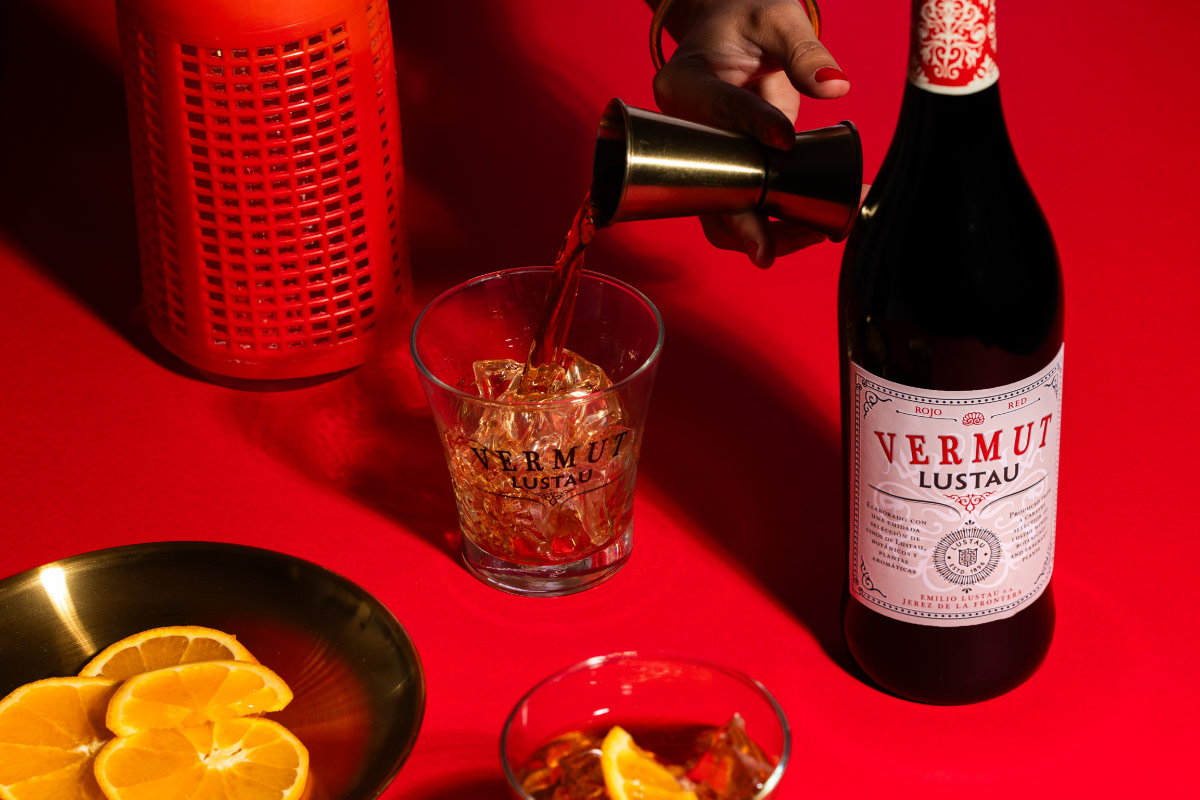
DISTINGUISHING VERMUT ROJO FROM OTHER APERITIFS
Aperitifs have long played a vital role in European drinking culture, serving both as appetite stimulants and elegant preludes to meals. Among them, aromatized wines form a broad family—subtly diverse yet unified by their base in wine and infusion with botanicals. Key members include vermouth, Americano, quinquina, Barolo Chinato, and Retsina, each distinguished by specific ingredients, techniques, and regional identity.

Vermouth is traditionally categorized into three primary styles: rojo (red), blanco (white), and seco (dry). Each style is distinguished by its unique color, flavor profile, botanical selection and sometimes wines used as base. Red vermouth is particularly easy to identify for its deep amber to reddish-brown hue, a characteristic achieved at Lustau through the addition of pedro ximénez wine. In this case, this wine not only imparts the signature color but also contributes to the vermouth’s complex flavor profile.
In contrast, blanco (white) vermouth typically presents a pale, straw-like color and leans towards herbaceous and floral-forwarded notes, offering a lighter yet rounded, bitter-sweet palate.
Seco (dry) vermouth, often clear or very light in color, is characterized by its crisp and slightly bitter profile, with herbal undertones and minimal sweetness. Made of very dry, briny wines such as manzanilla.
Vermouth rosé, less common than the other three, blends characteristics of both red and white vermouths, typically using a rosé wine base or combining white wine with a touch of red. The Lustau recipe calls for a coupage of fino, moscatel and tintilla de rota, featuring a balanced profile with delicate floral notes, soft bitterness, and subtle spice undertone.
THE ORIGIN AND HISTORY OF VERMUT ROJO
Vermouth, like many other alcoholic beverages, has its origins in ancient Europe, particularly in Classic Greece. However, it wasn’t initially created for enjoyment but as medicine. In Greece, doctors often mixed wine with medicinal herbs to create restorative tonics with analgesic and anti-inflammatory properties. Hippocrates was the prominent figure in this practice and is traditionally believed to be one of the first to mix wine with wormwood and dittany leaves, resulting in what was called “Hippocratic wine.”
Despite vermouth’s strong connection to Mediterranean countries, it has also been quite popular in Northern Europe. For instance, in 1570, Giovanantonio Soderini wrote that vermouth had German and Hungarian origins, referring to an aromatic beverage made in the Balkans called “Polí.” The name “vermouth” itself dates back to the 18th century when these aromatized wines began to be known by this name, derived from the German “wermut.” This historical journey illustrates the widespread appeal and influence of vermouth beyond its Mediterranean roots.
To understand vermouth as a beverage for enjoyment, we need to journey further into the 19th century, arriving in Turin. Antonio Benedetto Carpano, residing in the city of Turin, received a recipe of Bavarian origin called “wermut wein,” made with a base of wine and a blend of herbs from the Alps. After many tests and blends, he managed to create a recipe that became very popular among artists and the wealthiest people of the city. This marked the birth of the aperitif wine, transforming vermouth into a beloved drink for pleasure and social enjoyment.
From this point forward, vermouth transcended not only the borders of Turin but also Italy’s. In 1821, Chambery vermouth emerged thanks to various producers of this region. They created a white and drier vermouth compared to the original one made in Turin. During the same era, the popularity of vermouth also reached Spain, with two main regions adopting this product and adapting it to their local and regional culture: Reus and Jerez. This expansion marked the globalization of vermouth, making it a beloved and culturally diverse drink.
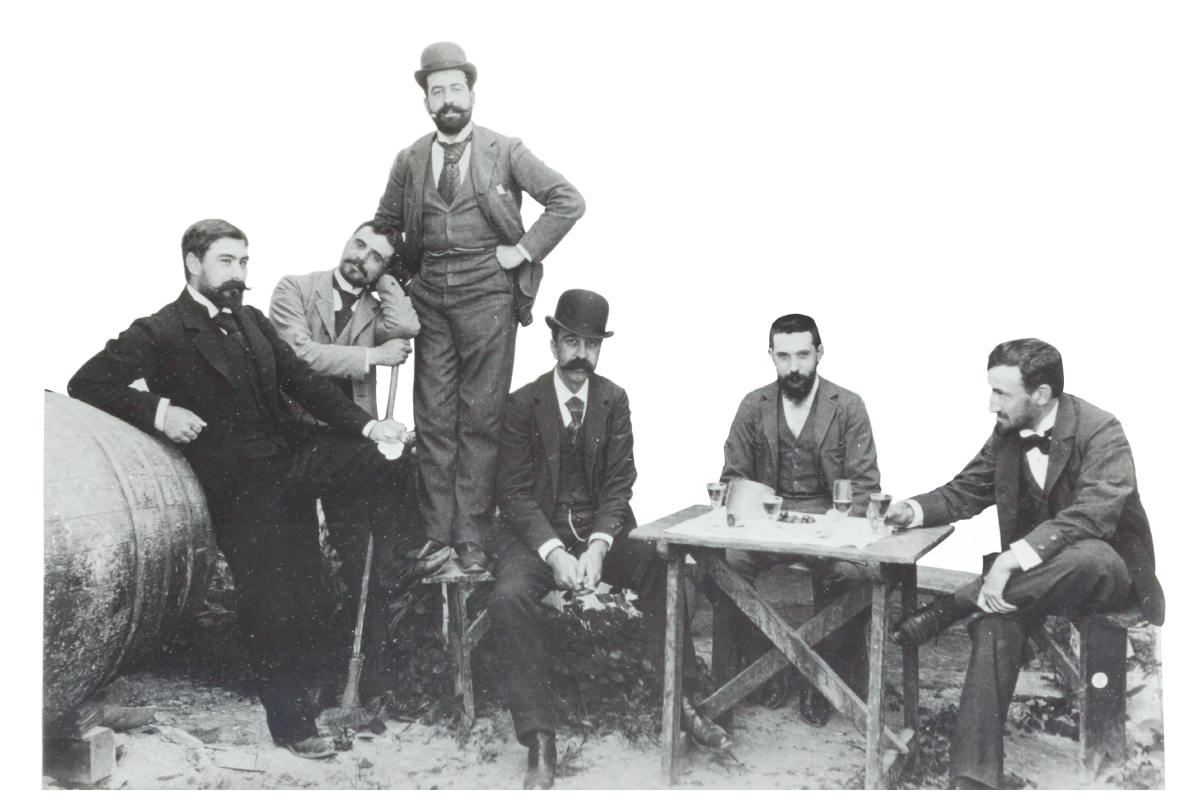
THE WINEMAKING PROCESS FOR VERMUT ROJO
WINE SELECTION AND BASE WINE PREPARATION
The base wine is often chosen based on its ability to provide an integrated, structured foundation for the final vermouth. Typically, red vermouths are made from dry neutral wines, which bring richness and create a white canvas for the botanical part to stand out.
Opposed to the general rule, Vermut Lustau Rojo is crafted with a careful selection of two expressive, full of personality wines. This base wine provides a rich, nutty, and dry character, sweetened by a velvety, silky, sweet fruity wine. Amontillado and pedro ximénez are responsible for Lustau’s red vermouth, forging a genuine character in this vermouth.
GRAPE SELECTION AND INITIAL FERMENTATION
Like other dry wines from the Jerez region, amontillado is exclusively made from free run palomino grape must (“mosto yema”), a variety known for its immense versatility (hence the diversity of dry sherry wines expressions) and ability to express terroir. Palomino produces delicate yet versatile base wines offering a vast and diverse spectrum of personalities, identities.
Palomino is generally harvested in the middle of summer. After a gentle pressing with a light contact with grape’s skins the juice (known as segundo pie) undergoes fermentation, typically in stainless steel tanks, resulting in a dry, light white wine with an alcohol content of around 11-12% Abv.
FORTIFICATION AND BALANCING SWEETNESS
Before botanical maceration, the base wine is fortified with grape spirit to increase alcohol content, typically between 15-18% ABV. The reason why the majority of aromatized wines are fortified is because botanical maceration lowers alcohol content of the base wine once mixed with it the latter, provoking a dilution in structure, flavor and strength and leading to a flabby texture in most of the cases. Fortification therefore is critical to get to a solid, cohesive and balanced vermouth.
Although sherry-based vermouths such as Vermut Lustau Collection are already fortified and start their journey as vermouth with a higher alcohol content than still wines, sometimes, refortification is needed.
INFUSION OF BOTANICALS: THE HEART OF VERMUT ROJO
Botanicals, including plants, herbs, spices, flowers, roots, or fruits, among others, provide the characteristic flavor and aroma of vermouth. Despite the multitude of recipes and vermouth types, the aroma is often unmistakable thanks to the botanicals of the recipe. Ingredients like wormwood and gentian are responsible for contributing to the authentic aroma and flavor of any vermouth. Understanding and mastering the precise contribution of each botanical will result in a balanced vermouth where each botanical plays a role in achieving a harmonious aroma and flavor.
In Vermut Lustau Rojo there is only 10 botanicals, carefully selected to enhance wine base and complement the already deep and complex personality of both amontillado and pedro ximénez that make this red vermouth:
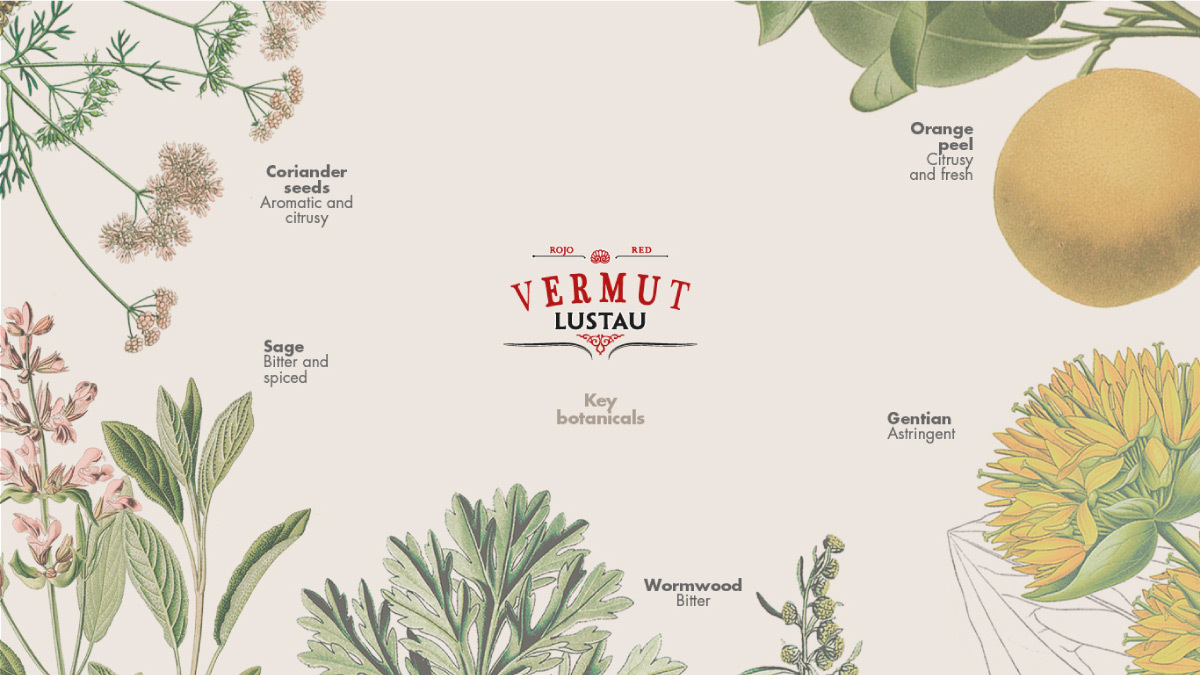
• Flavor Profile: botanicals are responsible for the complex and unique flavors of vermouth. Ingredients like wormwood, gentian, cinchona, and various herbs and spices provide bitter, sweet, and herbal notes, creating the signature taste of vermouth.
• Aroma profile: the aromatic botanicals used in vermouth production, such as thyme, marjoram, and citrus peels, contribute to its enticing scent. The combination of botanical aromas is what makes vermouth so fragrant.
• The extraction method: This process involves macerating or distilling botanicals to extract their essential oils and flavors. These concentrated botanical essences are then carefully blended to achieve the desired taste and aroma in vermouth. The choice of extraction method and the duration of maceration play a significant role in determining the final product’s character.
At Lustau, in order to achieve the optimum extraction of the botanical’s essence, each one is macerated separately. Afterwards, these essences and aromas are incorporated into the wine and the blend is left to repose. For 6 months the blend gains in consistency allowing both the botanical’s and the wine’s aromas to integrate perfectly.
AGING AND BLENDING: CRAFTING THE FINAL PROFILE
Some premium vermouths undergo a period of aging or maceration in oak barrels, which enhances complexity and mellows the flavors. It is not the case of Vermut Lustau, whose wines have been aged for years in old casks (sherry casks) following the solera and criadera system.
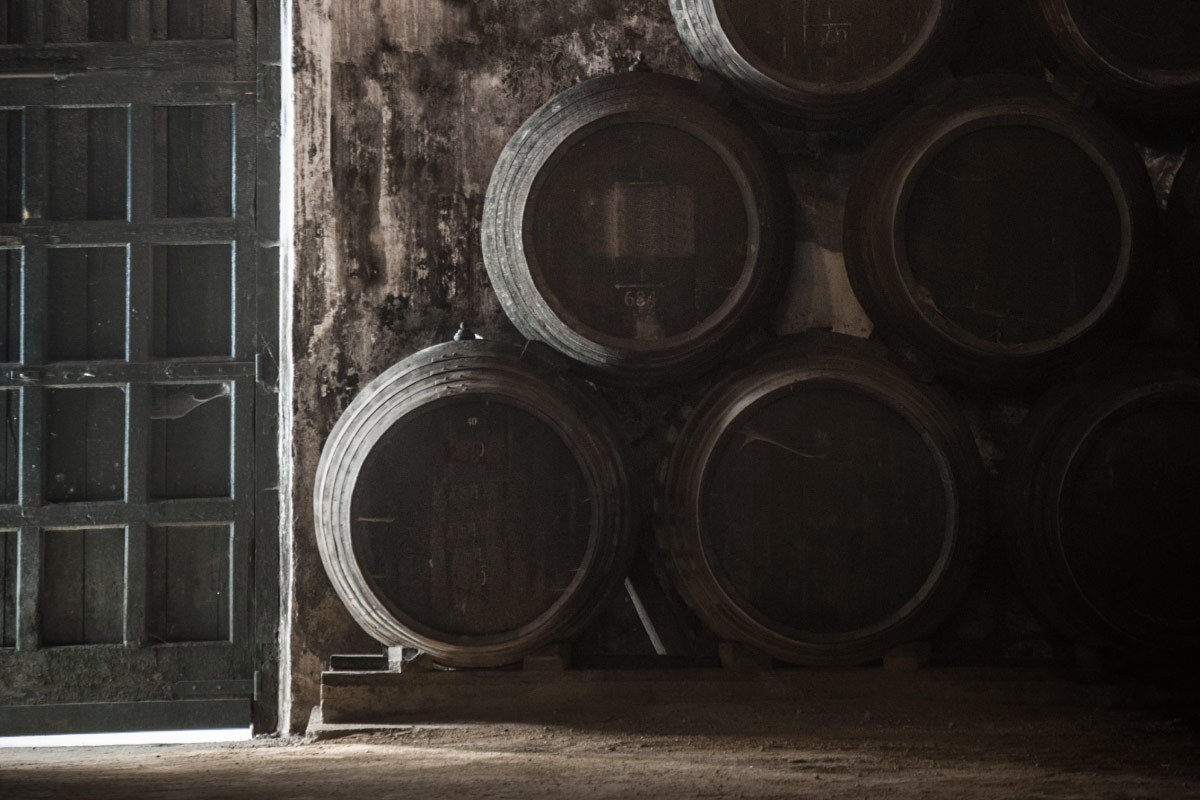
BOTTLING AND PRESENTATION
After six months of maceration Vermut Lustau Rojo is bottled in dark glass to protect the complex aromas, preserving its quality and genuineness. This vermouth’s label reflects the heritage of Bodegas Lustau and traditional and artisanal roots of this product. Elements of the label pay homage to the architecture of Jerez and Andalucía, heavily influenced by many different cultures and artistic styles.
Learn more about sherry’s legacy and the origin of the word “sherry”.
KEY CHARACTERISTICS AND FLAVOR PROFILE OF VERMUT ROJO
One of the most captivating aspects of Vermut Lustau Rojo lies in its personality — a complex dance of aromas, flavors, and textures that reflect Lustau’s characteristic versatility and diversity. This vermouth is perfect whether enjoyed on its own (following the Mediterranean way) or as part of a cocktail, a defining distinctive differentiation of Vermut Lustau Rojo.
AROMAS, TASTING NOTES, AND MOUTHFEEL
Vermut Lustau Rojo is crafted from a blend of two iconic Lustau sherries: dry, nutty amontillado, which lends structure and a distinctive smoky background, and sweet, velvety pedro ximénez, which contributes rich notes of ripe figs and raisins. The result is a mahogany-colored vermouth with reddish highlights, offering sweet aromas of dried and ripe fruits intertwined with citrus peel, herbal nuances, and a subtle hint of smoked wood. On the palate, it is smooth, flavorful, and beautifully balanced, finishing with a pleasant bitterness and a refined nutty aftertaste that lingers elegantly.
COMPARING VERMUT ROJO TO BLANCO AND SECO VERMOUTH
Red Vermouth (Vermut Rojo): This is the most popular and widely consumed style in Spain. It tends to be sweet and is made with white wine to which caramel color or other darker wines are added to give it its characteristic hue. It has a less bitter and dry palate compared to other types, with spices taking the spotlight in its profile. In red vermouth, you can find notes of vanilla, baking spices, fruit, and balsamic hints.
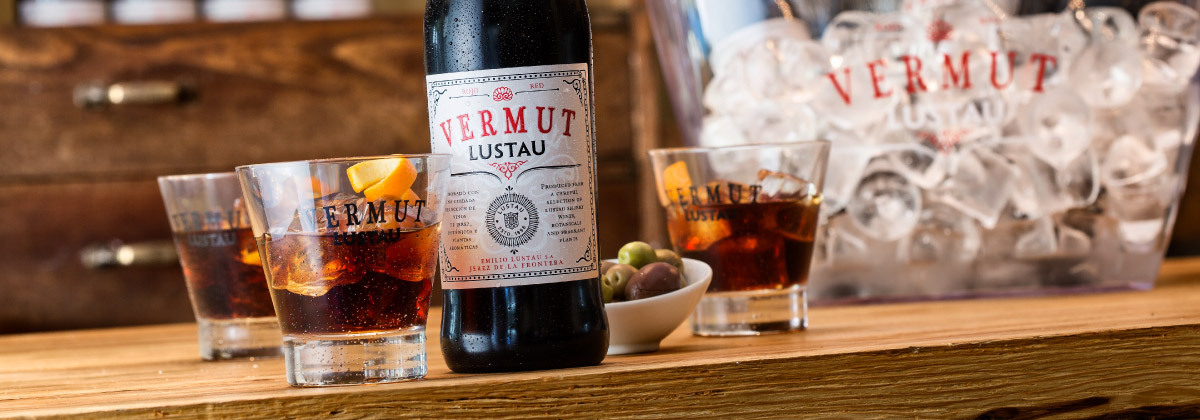
White Vermouth (Vermut Blanco): Lustau’s recipe is crafted by blending two wines: a dry, mineral and crisp fino sherry and a sweet and floral moscatel wine that impact the entire personality of this vermouth. This vermouth has an intense and bright yellow color, showing floral, citrusy and herbaceous notes on the nose. The finish is bitter and clean with a long, nutty and refreshing aftertaste.
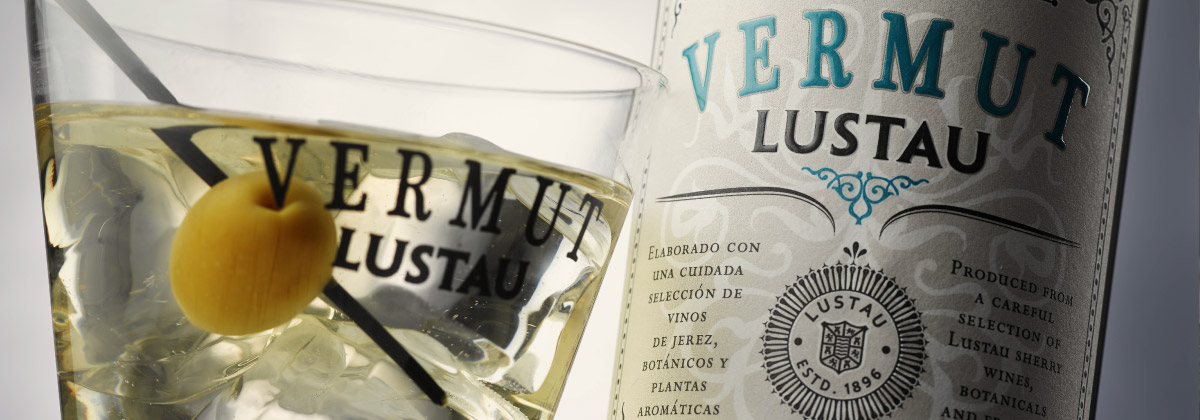
Dry Vermouth (Vermut Seco): Dry vermouth, of French origin, is quite similar to white vermouth in terms of botanical presence, typically herbs, roots, and flowers. Due to its drier and astringent profile, it is mainly used in classic cocktails. Vermut Lustau Dry is crafted with a delicate yet complex, dry and salty manzanilla, aged in Sanlúcar de Barrameda, a fishing town on the estuary of the Guadalquivir river.
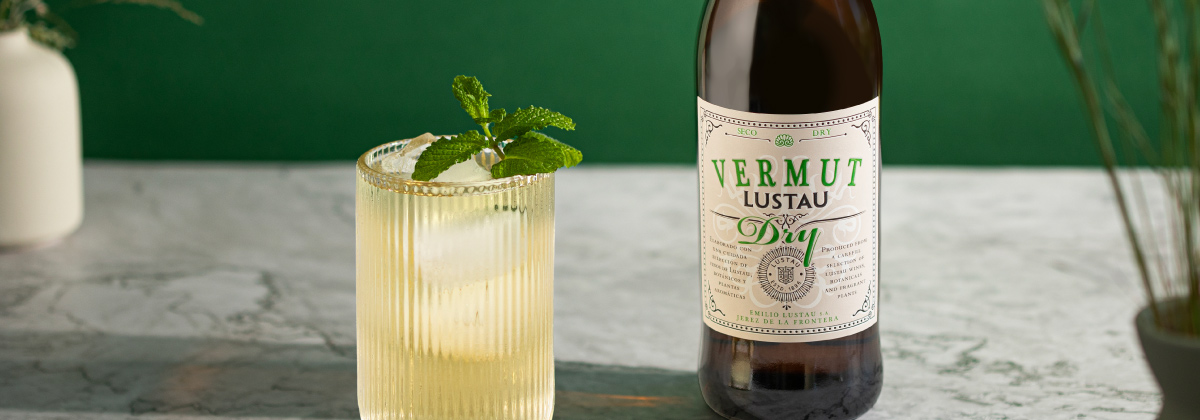
Rose Vermouth (Vermut Rosado): This is an alternative and recent variety of vermouth. Its popularity is relatively recent, becoming increasingly known and appreciated for being a fresh vermouth that combines the spiciness of red vermouth with the herbaceous characteristics of white or dry vermouth. Lustau Vermut Rosé was crafted looking for a perfect blend of three wines: a dry and crisp fino sherry, a floral and sweet moscatel and a lively and fruity tintilla de Rota red wine. This vermouth showcases an attractive and delicate pink-orange color. It is floral and herbaceous, highlighting lively fruity and spicy scents to the nose. On the palate, the spiced and herbaceous notes are followed by a comforting sweetness that leaves a delicious silky sensation.

FOOD PAIRINGS AND SERVING SUGGESTIONS FOR VERMUT ROJO
Enjoying vermouth is a delightful experience. It is used more than ever in many cocktail bars around the world. However, high quality vermouth is much more than a cocktail ingredient. Discover below different ways to enjoy vermouth.
• Food Pairing: food and vermouth are strongly connected in Spain thanks to “la hora del vermut”. Red vermouths have been traditionally paired with nuts, olives, cheeses, high quality tinned fish or pickles. However, vermouth allows for a wider range of accompaniments to delicious meals and the best part of this is that just a simple bite can work perfectly. Check the pairing and cocktails below for a solid proof to Vermut Lustau Rojo versatility:
BEST COCKTAILS WITH VERMOUTH ROJO
• Sip it neat or on the rocks: Some high-quality vermouths such as Lustau Vermut can be enjoyed on their own. Pour some vermouth into a rock glass over ice with a twist of citrus fruit or green olive for a simple but elegant way to enjoy vermut. This is the most common way to drink vermouth in Spain and it is part of the aperitif hour (or in Spain, “la hora del vermut”) that calls for a glass of vermouth on the rocks served before lunch or dinner.
• Classic Cocktails: is a key ingredient in classic cocktails like the Martini, Negroni, and Manhattan. Vermouth is experiencing a revival in the cocktail world, being included together with other fortified wines such as sherry wines in many modern recipes too. If you want a sherry-based cocktail, try any of these recipes.
• Vermouth and Tonic: Mix vermouth with tonic water for a refreshing, low ABV option. Lovely if you are looking for something light, refreshing but complex and very aromatic.







